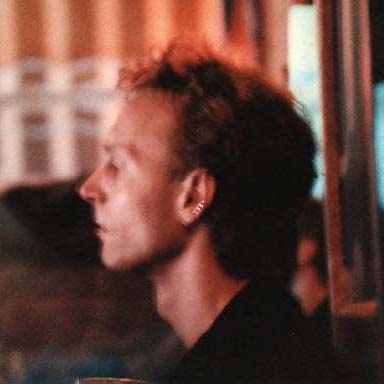
Music Distribution
We are currently experiencing some short-term hiccups with our physical CD distribution: in the meantime please click on the album links on our Albums page and hit the Amazon buying links to check if your title is available .
Download sales continue to be available via the usual services and you can also still stream our music as usual.

Music Distribution
We are currently experiencing some short-term hiccups with our physical CD distribution: in the meantime please click on the album links on our Albums page and hit the Amazon buying links to check if your title is available .
Download sales continue to be available via the usual services and you can also still stream our music as usual.
Words
A collection of essays, articles and short stories written by various associates of the Stereo Society.
Joy Of Sound.
I had a disturbed childhood, growing up in Detroit. My imagination – the places I could go to, and the things I found there, was often my only sanctuary. It wasn’t long before I discovered that there was a great therapeutic value in making a noise. Whether it was the relief of a good cry, the delightful effect of laughter, or the thrill of a scream – I always felt better afterwards. It seemed a shame to have to wait for the next…..
Writing Notes: An Introduction.
I couldn’t possibly list my favorite novels or authors. I certainly couldn’t list them in any order of merit Sometimes it’s the story, and sometimes it’s the way it’s told, that makes the book special. Novels can be brilliant in some parts and tedious in others. What I do know is that I now have tremendous respect for anyone who writes a novel. It’s a big job. One book that had considerable effect on me is, ‘The Night Of The Hunter’ by…..
Legacy: original fiction.
Corrie came closer to the fire. She stood there a while, then shivered. Pa was watching. Slowly, she stretched her thirteen-year-old fingers as far as she dared towards the warmth.
Pa stood up. He lumbered towards her. “The gal’s learnin’ good,” he grunted. Pa squeezed Corrie hard, then shot a glance to the gaunt figure in the corner. “We ain’t got much Ma,” he said. “Least we’re alive.”
Corrie gasped. Pa released her and went over to the table. She rubbed her shoulder and stared into the flames. Sure is an ice-cold world, she…..
Composing Polymicrotonally.
The complex world in which we live requires a new music that reflects what is special in this millennial era and, paradoxically, need not be overtly complex in its delivery. The insistence of a single tuning simply does not attract my aesthetic compass. Most significantly, communication in music demonstrably improves when one chooses from an unlimited set of meaningful intervals. The concept of writing music “microtonally” appears fairly well understood in the late ’90s, although music composed outside of conventional 12-tone equal
Logistics: Before The Music Gets Physical.
Music creation and recording gets pumped up to such a mythical level that it begins to rival the virgin birth. Perhaps the fantasy is fun, but it can be very confusing and misleading. The mass media and their subjects have a vested interest in exaggeration and exclusivity; the basic exercise is really much more mundane and, at least on the surface, perfectly comprehensible. Making a record is as much an exercise in military logistics as poetic passion…..
The Recording Studio: Rise And Fall Of An Institution.
The recording studio might be one of the least pleasant of all human environments. A typical contemporary studio has no windows. The control room pretends to be air-conditioned, kept cool if only for the comfort of the equipment in it, and if it really works the powerful fans always seem to blow freezing cold air down the back of your neck. Our human environment is compromised in the same way as professional kitchens, which are often not air-conditioned, lest the food cool too quickly. There is a carefully controlled, claustrophobia-inducing…..
Dancing: Into The Eighties.
In 1981, I produced Tainted Love, for Soft Cell. It was to be an enormous record, number one in 17 territories, and until very recently held the record for the longest stay in the US Billboard Hot 100 singles chart. The nine-minute, 12″ single starts with the Ed Cobb song, of which a version by Gloria Jones had been a hit on the English northern soul circuit. After this song finishes, at under three minutes, we get an instrumental interlude which then…..
Delivering the Music: All Change.
Lots of fancy essays and five-dollar words are written about media and how different formats influence performers and audiences. Different surroundings transmit differently and vary the music’s impact on the audience. When innovation arrives, such as DVD or the Internet, there will always be an exciting but confusing settling period while standards are defined and habits form. Since large corporate interests will be competing for the new turf…..
Surround Sound
Surround Sound: An Introduction (2001) by Mike Thorne
Quadraphonics and Music (1974) by Mike Thorne. Originally published in Hi-Fi News and Record Review Annual, UK, 1974
About the musical possibilities of quadraphonic surround sound, and some speculation about potential future developments. The ideas and aesthetics still apply in today’s 5.1 surround sound environment.
The Production of Quadrafile. (2001)
Four sides and four quadraphonic systems: this double album released in 1975 had identical musical sides which differed only in their quadraphonic surround encoding system. The music varied from Pink Floyd’s Money to a special remix of parts of Tubular Bells. It sounded really good, but then quad went and died on us.
Recording Gurrelieder (1975)
By Paul Myers (Director, CBS International Masterworks) and Bob Auger (Bob Auger Associates). Originally published in Studio Sound, UK, June 1975.
In fall 1974, in one of the most complex sessions London has seen, Gurrelieder was recorded by CBS for stereo and eventual quadraphonic release. The musical, production and engineering background is covered, from both stereo and quadraphonic viewpoints.
Four Sides of the Moon (1975)
By Alan Parsons. Originally published in Studio Sound, UK, June 1975.
Pink Floyd were among the earliest innovators to use four channel sound, and Dark Side of the Moon has won many awards, including several for sound engineering. The author, who engineered these and many other sessions for the band, discusses the quadraphonic record production, and contrasts it with the presentation of multichannel sound on stage.












